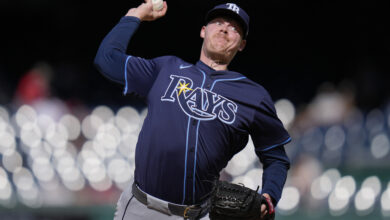
Low Expected Batting Averages in Houston Indicative of MLB’s Increased Homer Rate
As fans, we all love watching our favorite players hit home runs. Luckily for us, we are tuned into a game that is experiencing a home run explosion in recent years, a trend that does not seem to be waning.
Since Statcast began tracking such numbers in 2015, average launch angle has increased better than two degrees while barrel rates have ticked up more than 2.5 points to 7.9%. In turn, we are seeing a barrage of longballs across the baseball landscape. Thus far in 2019, there have been 2,239 home runs hit in 63,911 plate appearances. For perspective hitters mashed 2,079 home runs in a similar sample size in 2017, a number that actually fell to 1,889 in 2018.
While the flyball rate is holding steady around 35-36% during that three year sample size, the biggest change centers around the shear number of those fly balls that leave the ball park. Two years ago, the HR/FB rate sat in the mid-13% range, falling a point in 2018. This season, however, that mark has ballooned to 14.7% as we close out May.
Without a major increase in flyball numbers to back up the uptick in home runs, one could turn to the higher barrel rate and launch angle discussion mentioned earlier. While that may help explain a portion of what is transpiring across game, people who are on the field everyday seem to be of a different mindset.
“There’s something going on,” Joe Maddon said after a 9-6 loss to the Houston Astros on Tuesday. “I’m not a conspiracy guy, I am not. But the ball — you can really gauge it on the balls toward the ceiling more than anything. The ball that (David) Bote caught literally almost hit the roof. I don’t know.
“Whoever wants to admit to something or not. I don’t know if it is a combination of the ball… maybe the bat. Maybe the technology with the bat has gotten better. I don’t know that. Maybe it’s just purely about velocity. Or maybe there’s helium in this ballpark. But it’s friggin’ jumping man.”
You’d expect Minute Maid Park to play small, what with a 315-foot short porch in left field, but it actually ranks toward the middle of the pack in park factors. It was a bit surprising to see what looked like pop-ups off the bat find the seats, a phenomenon that resulted in an equally surprising lackluster expected batting average.
If you are not familiar with expected batting average (xBA), it “is a Statcast metric that measures the likelihood that a batted ball will become a hit.” In short, the statistic takes into account exit velocity and launch angle and uses prior batted balls with similar profiles to formulate a xBA. Even if you don’t have the data-science chops, you can probably figure out that a home run should have a high xBA.
Take, for example, Kris Bryant‘s 419-foot blast in the 3rd inning of Wednesday’s win over the Astros. Off the bat at 103.4 mph with a 26 degree launch angle, the shot generated an .860 xBA and earned a “barrel” distinction (which simply means he hit it really well). That means that 86% of the time, a ball hit like that will result in a hit. On Wednesday, that batted ball ultimately proved the difference in the Cubs’ 2-1 victory.
While Bryant’s home run was indicative of a close to perfect hit, the same cannot be said for many of the homers in Houston. Of the 12 total home runs hit between the two clubs, six finished with xBA’s lower than .500, while another two posted a .570 mark. To further the point, three of the longballs had expected batting averages in the .300’s, meaning close to 70% of the time, similar batted balls are turned into outs.
These low xBA’s are quite likely a result of the metric not taking into account the carry on a baseball. Already this season, players and analysts alike have speculated the baseball might be “juiced,” with a more tightly wound core that creates better carry during flight. In the Houston series, many balls that came off the bat in excess of 30 degrees seemed to carry forever before they were deposited into the bleachers.
For a visual, here is Kyle Schwarber‘s leadoff home run on Wednesday.
Play ball!#EverybodyIn pic.twitter.com/P2j9W18Yg4
— Chicago Cubs (@Cubs) May 30, 2019
If you need proof that the ball carried a bunch, just look at the Astros left fielder who thought he had a play on it. After briefly stopping on the warning track, he took an additional three or four steps back before running out of room.
While the above baseball exited Schwarber’s bat at 100.5 MPH, it was rocketed into the air at a 36 degree launch angle, hardly the ideal number if you want to hit home runs. But instead of dying on the track like so many balls hit that high have in the past, Schwarber’s carried into the crowd, leaving a .370 xBA in its wake and making fans wonder how it left the field of play.
As we continue forward this season, expect to see more of what happened this week in Houston. Yes, Minute Maid is a hitter-friendly park, but low xBA’s only provide further evidence that something is different with the baseball this season. As MLB combats a phantom pace-of-play issue and a waning fan base, “juicing” the ball could be an alternative to other major changes kicked around this past offseason.
Five Cubs have already hit 10 or more homers on the season and the team has walloped a club-record 51 homers in May with one game left to add to that tally. Even if little comes in the way of explanation, this will certainly be a fun trend to follow.

